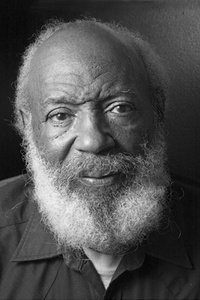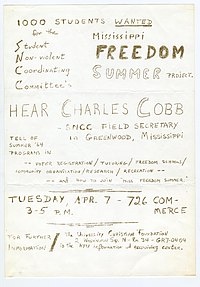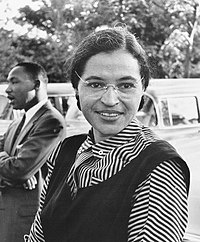-
Use Cases
-
Resources
-
Pricing
Civil Rights Movement in the United States Timeline
(1954 - 1968)Legal Developments
Brown v. Board of Education
May 17, 1954
% complete
Brown v. Board of Education was a landmark Supreme Court case in which the Court declared state laws establishing separate public schools for Black and white students to be unconstitutional. The case was brought by the parents of Linda Brown, a third-grade Black student in Topeka, Kansas, who was denied admission to her local elementary school because of her race. The Supreme Court's unanimous decision in May 1954 overturned the previous 'separate but equal' doctrine established in Plessy v. Ferguson (1896), stating that separate educational facilities are inherently unequal. This ruling paved the way for the desegregation of schools across the United States.
Civil Rights Act of 1964
Jul 2, 1964
% complete
Voting Rights Act of 1965
Aug 6, 1965
% complete
The Voting Rights Act of 1965 is a landmark piece of federal legislation in the United States that prohibits racial discrimination in voting. It was signed into law by President Lyndon B. Johnson on August 6, 1965. The act sought to improve and enforce voting rights for African Americans, particularly in the southern states where racial discrimination was widespread. The act had a significant impact on increasing voter registration and political participation among African Americans, and it is considered one of the most important civil rights laws in the history of the United States.
Image source: Voting Rights Act of 1965

Civil Rights Act of 1968
Apr 11, 1968
% complete
The Civil Rights Act of 1968, also known as the Fair Housing Act, was signed into law by President Lyndon B. Johnson on April 11, 1968. This legislation prohibited discrimination in the sale, rental, and financing of housing based on race, color, religion, or national origin. The act was a response to the civil unrest and racial tensions that had erupted across the country following the assassination of Dr. Martin Luther King Jr. The Fair Housing Act aimed to address systemic racism and promote equal opportunity in housing for all Americans.
Protests and Demonstrations
Montgomery Bus Boycott
Dec 1, 1955 - Dec 20, 1956
% complete
The Montgomery Bus Boycott was a political and social protest campaign against the policy of racial segregation on the public transit system of Montgomery, Alabama. It was sparked by the arrest of Rosa Parks on December 1, 1955, for refusing to give up her seat to a white man on a city bus. The boycott lasted for 381 days, from December 5, 1955, to December 20, 1956, and eventually led to a Supreme Court ruling that declared racial segregation on public buses unconstitutional.
Little Rock Nine Integration
Sep 25, 1957
% complete
On September 25, 1957, nine African American students known as the Little Rock Nine attempted to enter Little Rock Central High School in Arkansas. This event marked the first major test of the implementation of the Supreme Court's landmark ruling in Brown v. Board of Education (1954), which declared segregation in public schools unconstitutional. The students were met with violent opposition and were initially prevented from entering the school by the Arkansas National Guard. Eventually, President Dwight D. Eisenhower intervened and federalized the National Guard troops to ensure the students' safe entry into the school. This event received national attention and highlighted the ongoing struggle for racial equality and desegregation in the United States.
Image source: Little Rock Nine

Sit-in at Woolworth's
Feb 1, 1960 - Jul 25, 1960
% complete
Sit-in at Woolworth's was a nonviolent protest in Greensboro, North Carolina, where four black college students sat at a segregated lunch counter and requested service. Their request was denied, but they continued to sit at the counter in peaceful protest for several days. This act of civil disobedience sparked a wave of similar sit-ins across the country, challenging segregation laws and practices.
Greensboro Sit-ins
Feb 1, 1960 - Jul 25, 1960
% complete
The Greensboro Sit-ins were a series of nonviolent protests against racial segregation in Greensboro, North Carolina. It began on February 1, 1960, when four black college students sat down at a segregated lunch counter at a Woolworth's store. They refused to leave until they were served, sparking a wave of sit-ins and protests throughout the South. The sit-ins lasted for six months, until July 25, 1960, when the store finally desegregated its lunch counter.
Freedom Rides Begin
May 4, 1961
% complete
The Freedom Rides were a series of bus trips through the American South in 1961 to protest segregation in interstate bus terminals. On May 4, 1961, the first group of Freedom Riders left Washington, D.C., bound for New Orleans. The riders encountered violent opposition from white supremacists along the way, with several buses being attacked and burned. Despite the violence, the Freedom Rides garnered national attention and ultimately led to the desegregation of interstate bus travel.
James Meredith Enrolls at Ole Miss
Oct 1, 1962
% complete
James Meredith, an African American student, enrolls at the University of Mississippi (Ole Miss) after a long legal battle. His enrollment triggers riots and violent protests on campus, which require the intervention of federal troops to restore order.
Image source: James Meredith

Birmingham Campaign
Apr 3, 1963 - May 10, 1963
% complete
The Birmingham Campaign was a strategic movement organized by the Southern Christian Leadership Conference (SCLC) to bring attention to the brutal segregation and racism in Birmingham, Alabama. The campaign began on April 3, 1963, with a series of nonviolent protests and civil disobedience, including sit-ins, marches, and boycotts. One of the most significant events of the campaign was the Children's Crusade, where thousands of school students participated in peaceful demonstrations and were met with violent opposition from law enforcement and white supremacists. The Birmingham Campaign drew national and international attention to the Civil Rights Movement and ultimately led to the desegregation of Birmingham and the passage of the Civil Rights Act of 1964.
March on Washington
Aug 28, 1963
% complete
The March on Washington for Jobs and Freedom took place on August 28, 1963. It was a massive protest march in Washington, D.C., calling for civil and economic rights for African Americans. The event is most famous for Martin Luther King Jr.'s iconic 'I Have a Dream' speech, which he delivered from the steps of the Lincoln Memorial. The march was organized by a coalition of civil rights, labor, and religious organizations, and approximately 250,000 people participated in the peaceful demonstration. It is considered one of the landmark events of the Civil Rights Movement and played a significant role in the passage of the Civil Rights Act of 1964.
Image source: March on Washington for Jobs and Freedom

Freedom Summer
Jun 21, 1964 - Aug 10, 1964
% complete
Freedom Summer, also known as the Mississippi Summer Project, was a voter registration drive sponsored by civil rights organizations including the Congress of Racial Equality (CORE) and the Student Nonviolent Coordinating Committee (SNCC). The project took place in Mississippi from June 21 to August 10, 1964. The goal of Freedom Summer was to increase African-American voter registration in the state, where they faced significant obstacles to exercising their right to vote. The project also aimed to educate and empower African-American communities, and to challenge the entrenched systems of segregation and racism in the South. Freedom Summer workers faced intense opposition and violence from white supremacists and local law enforcement. The event helped to shine a national spotlight on the struggles and injustices faced by African-Americans in Mississippi, and it ultimately played a role in the passage of the Voting Rights Act of 1965.
Image source: Freedom Summer

Selma to Montgomery March
Mar 7, 1965 - Mar 25, 1965
% complete
The Selma to Montgomery March was a series of protests that took place in Alabama in 1965. The march was organized to advocate for voting rights for African Americans, who faced significant obstacles and discrimination when trying to exercise their right to vote. The march began on March 7, 1965, when approximately 600 protesters attempted to cross the Edmund Pettus Bridge in Selma, but were met with violent resistance from state and local law enforcement. This event, known as 'Bloody Sunday,' drew national attention and prompted a larger march to be organized. On March 9, Martin Luther King Jr. led a second attempt to complete the march, but he turned back after a court order prohibited the protesters from reaching Montgomery. Finally, on March 21, a revised route was established and a federal court ruled in favor of allowing the march to proceed. The marchers reached Montgomery on March 25, where a rally was held on the steps of the Alabama State Capitol to advocate for voting rights. The Selma to Montgomery March played a significant role in the passage of the Voting Rights Act of 1965.
March from Selma to Montgomery
Mar 7, 1965 - Mar 25, 1965
% complete
The March from Selma to Montgomery, also known as the Selma to Montgomery March, was a series of civil rights protests that took place in March 1965. The marchers were advocating for voting rights for African Americans in the South. The first march attempt on March 7, 1965, known as Bloody Sunday, was met with brutal violence from state troopers. Following this, a second march was organized, which began on March 9 and lasted until March 25. The marchers, led by civil rights leaders such as Dr. Martin Luther King Jr., traveled the 54-mile route from Selma, Alabama to the state capital, Montgomery. The march successfully drew national attention and ultimately led to the passing of the Voting Rights Act of 1965.
Image source: Selma to Montgomery marches

March Against Fear
Jun 6, 1966
% complete
The March Against Fear was a major civil rights demonstration that took place in the United States in June 1966. The march was organized by James Meredith, the first African American student at the University of Mississippi, to protest against racism and discrimination. The march started in Memphis, Tennessee, and was intended to end in Jackson, Mississippi. However, on the second day of the march, Meredith was shot by a white supremacist, which led to widespread outrage and increased participation in the march. Civil rights leaders such as Martin Luther King Jr., Stokely Carmichael, and Floyd McKissick joined the march to show their support. The march eventually reached its destination in Jackson on June 26, with tens of thousands of participants demanding an end to racial inequality and injustice.
Image source: March Against Fear

Black Power Salute at Olympics
Oct 16, 1968
% complete
During the 1968 Summer Olympics in Mexico City, American athletes Tommie Smith and John Carlos raised their fists in a Black Power salute during the medal ceremony for the 200-meter race. This act of protest was in response to racial inequality and injustice in the United States.
Image source: 1968 Olympics Black Power salute

Key Figures
Rosa Parks Arrested
Dec 1, 1955
% complete
On December 1, 1955, Rosa Parks, an African American woman, was arrested in Montgomery, Alabama for refusing to give up her seat to a white passenger on a bus. This event became a symbol of the Civil Rights Movement and sparked the Montgomery Bus Boycott.
Image source: Rosa Parks

Martin Luther King Jr.'s "I Have a Dream" Speech
Aug 28, 1963
% complete
Martin Luther King Jr. delivered his famous 'I Have a Dream' speech on August 28, 1963, during the March on Washington for Jobs and Freedom. In this speech, King shared his vision of a future where racism and discrimination would be overcome, and where all individuals would be judged by the content of their character rather than the color of their skin. The speech is considered one of the most iconic moments in the Civil Rights Movement and played a significant role in shaping public opinion and policy towards racial equality.
Image source: I Have a Dream

Black Panthers Founded
Oct 15, 1966
% complete
The Black Panther Party is founded in Oakland, California by Huey P. Newton and Bobby Seale. The party aims to protect African American communities from police brutality and advocate for social, political, and economic equality.
Key Facts
- The Supreme Court ruling in Brown v. Board of Education declared racial segregation in public schools unconstitutional in 1954.
- Rosa Parks' refusal to give up her seat on a bus in Montgomery, Alabama, sparked the Montgomery Bus Boycott in 1955.
- The sit-in movement began in 1960 when four African American college students sat at a whites-only lunch counter in Greensboro, North Carolina.
- The Civil Rights Act of 1964 prohibited racial segregation and discrimination in public places and employment.
- The Voting Rights Act of 1965 aimed to overcome legal barriers that prevented African Americans from exercising their right to vote.
Source
This Civil Rights Movement in the United States timeline was generated with the help of AI using information found on the internet.
We strive to make these timelines as accurate as possible, but occasionally inaccurates slip in. If you notice anything amiss, let us know at [email protected] and we'll correct it for future visitors.
Create a timeline like this one for free
Preceden lets you create stunning timelines using AI or manually.
Customize your timeline with one of our low-cost paid plans
Export your timeline, add your own events, edit or remove AI-generated events, and much more
Free
$
0
free forever
No credit card required.
Basic
$
10
/month
billed annually
Cancel anytime.
Pro
$
16
/month
billed annually
Cancel anytime.
Common Questions
Can I cancel anytime?
Yes. You can cancel your subscription from your account page at anytime which will ensure you are not charged again. If you cancel you can still access your subscription for the full time period you paid for.
Will you send an annual renewal reminder?
Yes, we will email you a reminder prior to the annual renewal and will also email you a receipt.
Do you offer refunds?
Yes. You can email us within 15 days of any payment and we will issue you a full refund.
What if I have more questions?
Check out our pricing docs or send us an email anytime: [email protected].